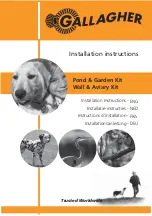
19
Fitting Field Test Audit (FC2)
go to commissioning FC1 (9.2)
2nd instance
follow maintenance
instructions (section 12)
1st instance
reset, follow
setting instructions
accept
& record
mixed temp.
same as at
commissioning
2.0 C
±
º
deviation from
previous >+2.0ºC
check mixed
temperature
restore cold
pass
fail
see 12
undertake the cold
water isolation test
see 9.5
water supplies same as
previous audit or
∆t change >5ºC
9.5
In-field ‘Cold Water
Isolation’(CWI) test.
Note: To gain access to the cold water
isolating
valve, unscrew the right hand shroud &
slide forward to expose the isolating
screw on top of the cold inlet leg.
Using a 5mm Allen Key, The isolation plug
can be screwed down fully to isolate the
cold water supply
Prior to commencing the CWI test, ensure:
1. The water supply conditions are met
either:
A. For commissioning a new product
(see table 1, section 4).
B. Or the inlet ∆t is within ±5°C to when the
product was commissioned (see 9.4).
NOTE It is important that the hot
temperature is greater than 55°C
2. Mixed water outlet temperature is
correct (see table 2, section 10).
To perform a CWI test, operate the product
using the sensor. Then conduct the follow-
ing procedure:
1. Record the steady state temperature of
both hot and cold water supplies.
Note the ∆t.
2. Record the temperature of the mixed
water at the outlet.
3. Isolate the cold water
supply & monitor the flow of water from
the outlet.
If the flow ceases, CWI test passed:
1. Restore the cold water supply by rotating the isolator screw 90° clockwise.
2. Slide the shroud back & screw onto the wall plate.
3. Re-check the temperature of the stabilised mixed water at the outlet to ensure it is still correct.
Accept & record mixed temperature.
If there is an ongoing flow of water from the mixed water outlet, then 5 seconds after CWI collect the
discharging water into a measuring vessel for 60 seconds. To pass the CWI test the volume of collected
water should be less than 120ml.
If the product fails CWI test, see FC2 (section 9.4). Follow product maintenance (see section 12) and
servicing (see section 10) instructions.
















































